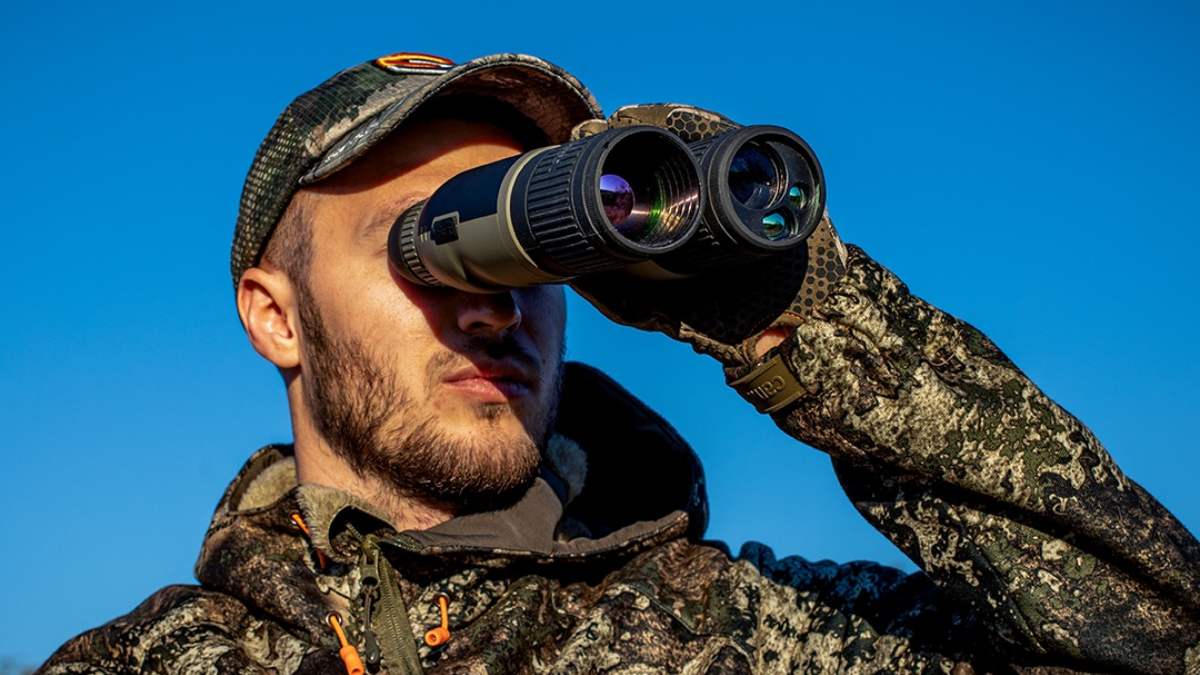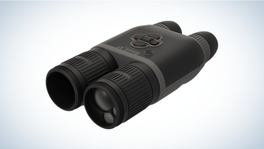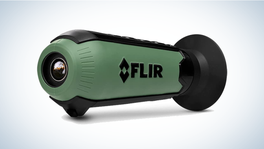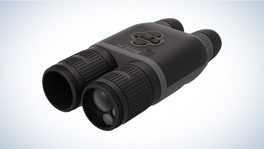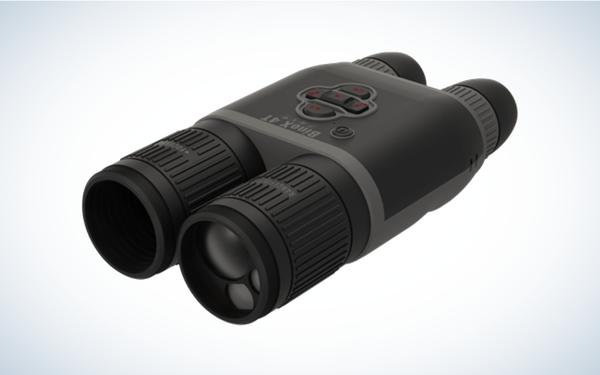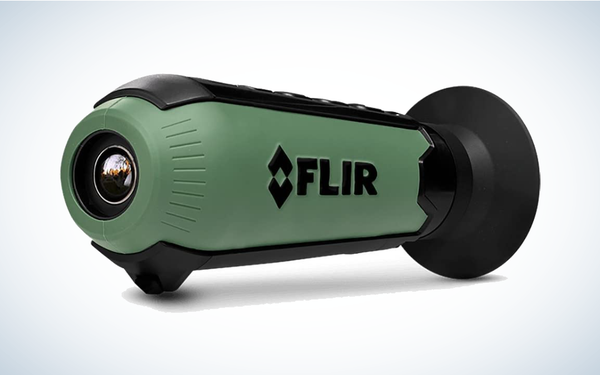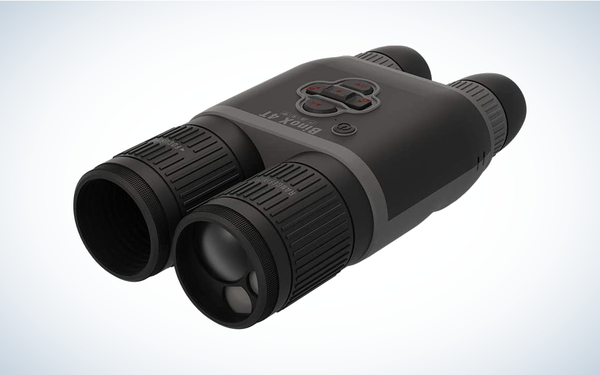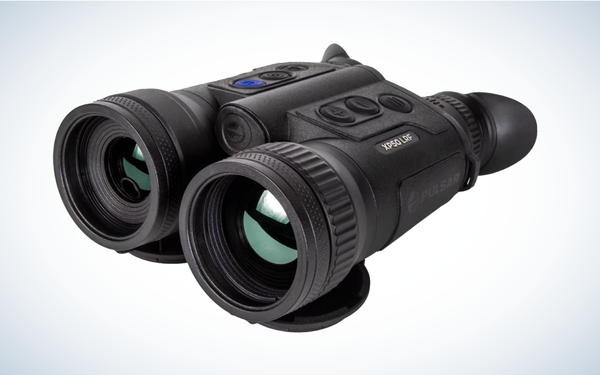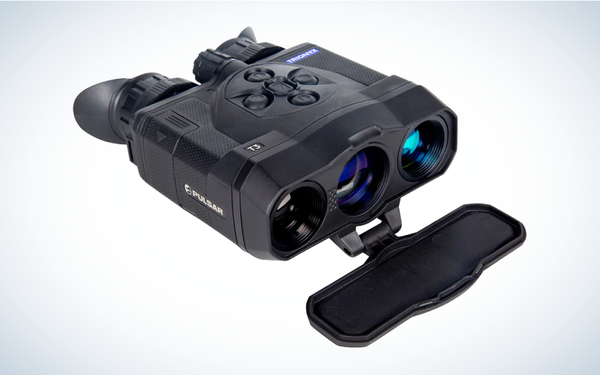We may earn revenue from the products available on this page and participate in affiliate programs. Learn more ›
With an explosion in recent years of invasive animals such as wild hogs, coyotes, armadillos, and more, hunting at night with thermal binoculars or a thermal scope has never been more popular—and sometimes necessary. Instead of relying on a nice, moonlit night to make your hunt successful, embrace the improvement in thermal binocular technology. The picture quality has gone up, price has come down, and there’s a pair of the best thermal binoculars (or even a monocular) that will fit your needs and your budget.
- Best Overall: ATN BinoX 4T 640 1.5-15x
- Best Budget: FLIR Scout TK Handheld Thermal Imaging Monocular
- Best for Hunting: ATN BinoX 4T 384 1.25-5x
- Best Premium: Pulsar Merger LRF XP50 Thermal Binoculars
- Best Thermal & Night Vision Combo: Pulsar Trionyx T3 Multispectral
How We Picked the Best Thermal Binoculars
Not all thermal binoculars are built the same. There’s a wide variety of options available and they’ve all got target uses. Undoubtedly there are times where you need the absolute best of the best with the most features. Other times, less is more. No matter the price point or the bells and whistles, one thing almost always holds true: You get what you pay for at both ends of the spectrum, but that doesn’t have to be a deal-breaker.
When it comes down to picking the thermal binoculars on this list, I used the following criteria:
- Build Quality: What materials went into making the thermal binoculars and how does that translate into the finished product? Do they perform like you’d expect for what it is, or does the image quality look like you’re playing on an old school Nintendo console? Are they built like a tank or do they need to be babied? Build quality will make or break a pair of thermal binoculars and can be the difference between a great night out hunting or an evening full of missed opportunities.
- Intended Use: Will you be using the thermal binoculars for population control of nuisance hogs? Or maybe you’ll be predator hunting and hoping to whack some coyotes. Perhaps still you’re going to be using them for some night time hunting reconnaissance. How you’ll use the binoculars will help determine what aspects should be focused on when making a final selection.
- Cost: Do these thermal binoculars provide a good value for the money? Are you getting what you would expect, or more, at a given price point?
Best Thermal Binoculars: Reviews and Recommendations
Best Overall: ATN BinoX 4T 640 1.5-15x
Specs
- 1280×960 video recording
- 1,000-yard detection range
- 4th gen 640×480 sensor
Pros
- Black-and-white or color modes available for user preference and application
- Identification range out to 300 yards
- Very impressive 16 hours of battery
Cons
- Heavier than others at 2.5 pounds
A thermal industry leader, the ATN BinoX 4T 640 offers a tremendous range of features and performance while still managing to balance that with a reasonable price. True, they’re not cheap, but there’s a heck of a lot of value packed into these binoculars. The 16-hour battery life is unheard of, and you’ll be ready to quit using them in one sitting before the battery is ready to die. Video recording capabilities, a 1,000 yard detection range and 300 yard identification range, as well as a super crisp display thanks to the 4th gen sensor make these ATN thermal binoculars a no-brainer for the user who is ready to step up their game and their capabilities.
Best Budget: FLIR Scout TK Handheld Thermal Imaging Monocular
Specs
- Small and lightweight: 6”x2”x2” and 6 ounces
- 5-hour rechargeable battery
- Weather-resistant shell
Pros
- Able to choose from multiple color palettes to fit your optimal viewing needs
- Easily see people and animals at more than 100 yards
- Capable of capturing photos and videos
Cons
- Can cause more eye strain over binoculars
To cut down on costs, you can cut down on size by halving binoculars and going with a monocular option like the FLIR Scout TK. Aside from a much more attractive price point, the smaller size and weight makes it easier to bring along your thermal device if you’re trying to pack light on a hunting trip. The weather-resistant shell and 5-hour battery life means that you can stay out longer regardless of the weather conditions, and you can even capture photos and videos to remember the experiences and share them with others. When you’re finished using the monocular, you can charge it with ease via the included USB cable.
Best for Hunting: ATN BinoX 4T 384 1.25-5x
Specs
- 1,000-yard rangefinder
- Built-in compass
- Recording and streaming capabilities
Pros
- BIX (Ballistic Information Exchange) tech allows ATNs SMART HD devices to communicate and exchange information between binoculars and scopes
- Built-in IR illuminator to help out hunting buddies using night vision
- Ability to tag animal locations that then show up in the app on your phone for easy tracking and monitoring
Cons
- Purists may think it takes the sport out of hunting
Take your thermal hunting to the next level with the amazing technological advances available from the ATN BinoX 4T 384. With these ATN thermal binoculars, there’s no need to carry a separate compass, rangefinder, or IR illuminator. They’re all built into this pair so that you can travel lighter on your hunt. You can record and even livestream your hunt at the same time for people who couldn’t make it out with you. Perhaps coolest of all, you can exchange information between these ATN binos and an ATN scope to help calculate things like holdover. If you don’t have an ATN scope, you can still use that information with a regular scope and their app. Technology is amazing—unless you’re a purist.
Best Premium: Pulsar Merger LRF XP50 Thermal Binoculars
Specs
- 20x digital zoom
- AMOLED display
- App connectivity
Pros
- Target detection all the way out to 2,000 yards – more than a mile!
- 10-hour battery life with automatic standby for tons of continued use
- Built-in 1,000-yard rangefinder
Cons
- Expensive
Pulsar is a leading name in thermal technology, and the Merger LRF XP50 makes it easy to see why. With WiFi capabilities, video and photo recording options with free cloud-based storage, unrivaled zoom levels that still maintain clarity, and exceptional range in terms of a rangefinder and target detection, it’s hard to beat these Pulsar thermal binoculars. If you’re looking for premium thermal, they’re the best. Just be prepared to pay up for the privilege.
Best Night Vision: Pulsar Trionyx T3 Multispectral
Specs
- 2.5x-10x thermal, 3.5x-14x night vision
- Fusion image of thermal overlay onto night vision
- AMOLED display
Pros
- Combines the best of night vision and thermal to overcome the limits of each
- Thermal range of 1,000 yards and night vision range of 450 yards
- Record video and share it via WiFi
Cons
- No built-in rangefinder
There are limits to both thermal and night vision, so by combining the two, the Pulsar Trionyx T3 Multispectral binoculars allow you to harness the benefits of each and use one to overcome the shortcomings of the other. You can easily find an object with thermal imaging, evaluate the terrain with digital night vision, and identify clearly all the object’s smallest features and details with a fusion image. When used in fusion mode, these thermal night vision binoculars display a combined image of digital night vision and thermal imaging. This enables visualization of the smallest object details while simultaneously highlighting hot areas of the object. It really is the best of both worlds.
What to Consider When Choosing Thermal Binoculars
Obviously, the final decision is up to you, but if you decide that your next big purchase is going to be a pair of thermal binoculars, here are some of the things you should think about before parting with your hard-earned money:
Intended Use
How are you planning on using the binoculars? Will it be for hunting down nuisance hogs or other predator animals at night or mainly for the fun of being able to see at night and do some shooting? While there are plenty of options out there that fill both of those needs, there’s no reason to buy a pair with a whole bunch of bells and whistles that you’ll never use. Buy what you need and save the difference for ammo.
Price
Price isn’t always indicative of quality. There are plenty of overpriced pieces of junk and there are equal numbers of underpriced overperformers. Figure out your budget and then focus on use and features. This will allow you to find exactly what you need at a price you can afford.
FAQs
Q: Can I use thermal binoculars during the day?
Yes, you can use thermal binoculars during the day. They are only affected by heat radiation and not light, like night vision. This means that you can safely use them even on the brightest of days without risking damage to them.
Q: Is thermal imaging legal for civilians?
While many people conjure up images of special ops soldiers using thermal imaging on high-risk missions, the truth is that thermal imaging is perfectly legal for civilians to own and use because its uses are far broader than just the military. Thermal imaging is a great tool for hunters, trappers, and when scouting for game.
Q: What is the difference between thermal imaging and night vision?
Thermal imaging, otherwise called infrared, doesn’t require any light to allow you to be able to see in the dark. Night vision, on the other hand, works by amplifying visible light in the immediate vicinity.
Best Thermal Binoculars: Final Thoughts
Whether you absolutely need a pair of thermal binoculars or you just want them because they’re cool, we’re not here to judge. The technology is pretty sweet, so if you’re ready to jump buy a pair of the best thermal binoculars, check out one of these top options from ATN, Pulsar, and more.
Why Trust Us
For more than 125 years, Field & Stream has been providing readers with honest and authentic coverage of outdoor gear. Our writers and editors eat, sleep, and breathe the outdoors, and that passion comes through in our product reviews. You can count on F&S to keep you up to date on the best new gear. And when we write about a product—whether it’s a bass lure or a backpack—we cover the good and the bad, so you know exactly what to expect before you decide to make a purchase.
